Related Research Articles

Sweden maintained its policy of neutrality during World War II. When the war began on 1 September 1939, the fate of Sweden was unclear. But by a combination of its geopolitical location in the Scandinavian Peninsula, realpolitik maneuvering during an unpredictable course of events, and a dedicated military build-up after 1942, Sweden kept its official neutrality status throughout the war. At the outbreak of hostilities, Sweden had held a neutral stance in international relations for more than a century, since the end of the Napoleonic Wars in 1814 and the invasion of Norway.
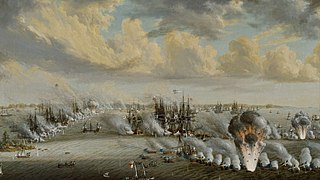
The Second Battle of Svensksund was a naval battle fought in the Gulf of Finland outside the present day city of Kotka on 9 and 10 July 1790. The Swedish naval forces dealt the Russian fleet a devastating defeat that brought an end to the Russo-Swedish War (1788–1790). The battle is the biggest Swedish naval victory and the largest naval battle ever in the Baltic Sea. It qualifies among the largest naval battles in history in terms of the number of vessels involved.
Sverker II or Sverker the Younger was King of Sweden from 1195 or 1196 to 1208 when he was defeated in the Battle of Lena by Prince Eric. Sverker died in the 1210 Battle of Gestilren where his forces battled those of King Eric X.

The Battle of Lund, part of the Scanian War, was fought on December 4, 1676, in an area north of the city of Lund in Scania in southern Sweden, between the invading Danish army and the army of Charles XI of Sweden. The Danish had an army of about 13,000 under the personal command of 31-year-old King Christian V of Denmark, aided by General Carl von Arensdorff. The Swedish army, which numbered about 8,000, was commanded by Field Marshal Simon Grundel-Helmfelt and the 21-year-old Swedish king Charles XI. It is one of the bloodiest battles in percent of casualties on both sides ever fought in Scandinavia.

The Battle of Warsaw took place near Warsaw on July 28–July 30 [O.S. July 18–20] 1656, between the armies of the Polish–Lithuanian Commonwealth and Sweden and Brandenburg. It was a major battle in the Second Northern War between Poland and Sweden in the period 1655–1660, also known as The Deluge. According to Hajo Holborn, it marked "the beginning of Prussian military history".

The invasion of Russia by Charles XII of Sweden was a campaign undertaken during the Great Northern War between Sweden and the allied states of Russia, Poland, and Denmark. The invasion began with Charles's crossing of the Vistula on 1 January 1708, and effectively ended with the Swedish defeat in the Battle of Poltava on 8 July 1709, though Charles continued to pose a military threat to Russia for several years while under the protection of the Ottoman Turks.

The Assault on Copenhagen also known as the Battle of Copenhagen on 11 February 1659 was a major engagement during the Second Northern War, taking place during the Swedish siege of Copenhagen.
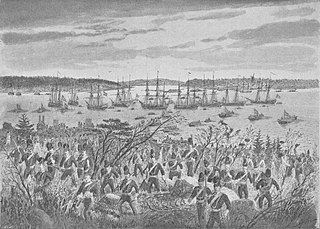
The Battle of Lemo was fought during the Finnish War between Sweden and Russia on 19–20 June 1808.
William Yngve Anderson was a Swedish-born American fighter ace of World War II, credited with seven official victories in Europe while flying P-51 Mustang fighters with the United States Army Air Forces.

Ingvar Fredrik Håkansson was a Swedish volunteer fighter pilot in the Royal Air Force (RAF) during the Second World War. Since Sweden was neutral in the war, Håkansson was one of few Swedes that served in RAF.

The Swedish invasion of Poland (1701–1706), also known as Charles XII's invasion of Poland or the Polish front of the Great Northern War, was a conflict in eastern Europe overshadowed by the ongoing Great Northern War fought between the Swedish Empire against the Russian Empire, Denmark-Norway, Saxony and the Polish–Lithuanian Commonwealth. The Polish front was a major part of the greater conflict, and it included some decisive battles in favor of the Swedes that contributed to the length of the war.

Lieutenant General Viking Sebastian Henricsson Tamm was a Swedish Army officer. In addition to the years he served in the Swedish Army, Tamm led a group of Swedish officers who developed the Ethiopian military school's officer training and he was a volunteer in the Winter War in Finland in 1940 commanding the II. Battlegroup of the Swedish Volunteer Corps. Back in Sweden he eventually became Chief of the Army Staff and the General Staff Corps (1948–53) and commander of the I Military District (1953–61) before retiring as a Lieutenant General in 1961.
Svante Grände was a Swedish aid worker and guerrilla fighter in Latin America during the 1970s. He was one of two known Swedish citizens to be killed in the Dirty War in Argentina, the other being Dagmar Hagelin.
Senior Colonel Ulf Hugo Henricsson is a former Swedish officer. He is best known for his achievements in the Bosnian War as commander of the peacekeeping operations from September 1993 to April 1994. There he commanded the Nordic battalion which was a part of the United Nations Protection Force (UNPROFOR).
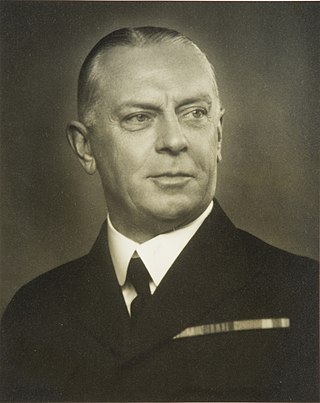
Major General Eric Virgin was a Swedish Air Force officer. Originally a Swedish Army officer, Virgin became commanding officer of the Svea Logistic Corps in 1926 and was appointed Inspector of the Swedish Army Service Troops the year after. In 1931 he was appointed Chief of the Air Force for the newly established Swedish Air Force. Virgin left the position as major general in 1934 to become advisor to the Emperor of Abyssinia. He left Abyssinia two days before the outbreak of the Second Italo-Ethiopian War in 1935; back in Sweden, he was placed in the Swedish Air Force reserve, where he remained until 1947. Virgin died three years later.

Lieutenant General Charles Gustaf Uno Malcolm Murray was a Swedish Army officer. Commissioned as an officer in 1925, Murray served in Finnish Army as part of the Swedish Volunteer Corps during the Winter War and as company commander in the Swedish Volunteer Battalion during the Continuation War. Back in Sweden, Murray served as regimental commander of Svea Life Guards, as Inspector of the Swedish Armoured Troops and as military commander of the II Military District. After retiring from the military, Murray served as head of the Crown Prince's Royal Household and as Chief of His Majesty's Military Staff
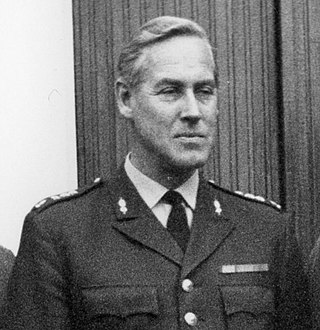
Lieutenant General David Tage Olihn was a senior officer of the Swedish Army. Olihn's senior commands include Inspector of the Swedish Armoured Troops and military commander of the I Military District and of the Lower Norrland Military District. Olihn also served in Finland during the Winter War in 1940 and in Abyssinia two times, from 1946 to 1949, and from 1956 to 1959.
The Attack on Camp Massart took place on 16 December 1961 and was an attack on Camp Massart, the heavily defended main base of the Katangese Gendarmerie during the Congo Crisis. The attack was part of Operation Unokat which aimed to break the roadblocks set up by the gendarmerie by the end of November 1961 and at the same time stop Katangese President Moïse Tshombe's opposition to the UN. In a coordinated offensive, Swedish troops captured Camp Massart; Irish troops attacked the railway tunnel; the Indian contingent created diversionary attacks and blocked fleeing Katangese forces; and the Ethiopian forces secured the western part of the city. The attack on Camp Massart begun in the early hours of 16 December and ended at around 1 pm when the Swedes captured the camp. Between 10 and 20 Gendarmes were killed in the attack. One Swedish soldier was killed and five were injured.
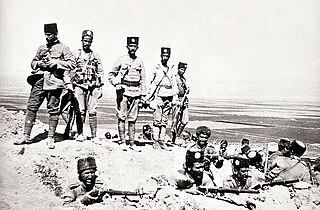
The Swedish volunteers in Persia were a small group of military officers deployed in Persia between 1911 and 1916. The goal was to quell regional uprisings and modernize the Persian army, but as a result of pressure from Russia and the United Kingdom, Sweden decided to call back most of their officers during World War I.
The Battle of Ubagall was a battle between soldiers of Carl Henriksson Horn and a Russian force under the command of Tiesenhusen in the village of Ubagall in 1571.
References
Citations
- ↑ Schmidt-Laussitz, Nicolas von. Svenskarna vid Jandeba: Svenska frivilligkompaniet 1942–1944. Förlag svenskafrivilliga.com, 2007, p. 160.
- ↑ Gyllenhaal, Lars, Westberg, Lennart. Svenskar i krig 1914–1945 (e-book version). Historiska Media, 2014, chapter I Finländsk tjänst 1914–1944, section Svirkompaniet.
Sources
- Gyllenhaal, Lars, Westberg, Lennart. Svenskar i krig 1914–1945 (e-book version). Historiska Media, 2014, chapter I Finländsk tjänst 1914–1944, section Svirkompaniet.
- Schmidt-Laussitz, Nicolas von. Svenskarna vid Jandeba: Svenska frivilligkompaniet 1942–1944. Förlag svenskafrivilliga.com, 2007.